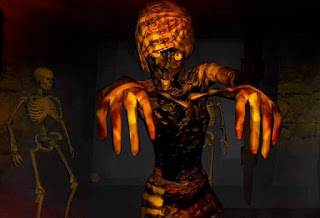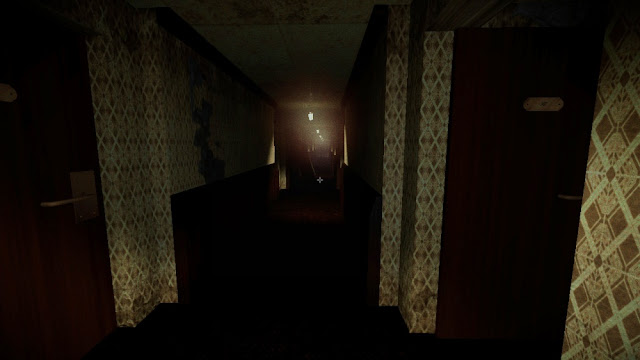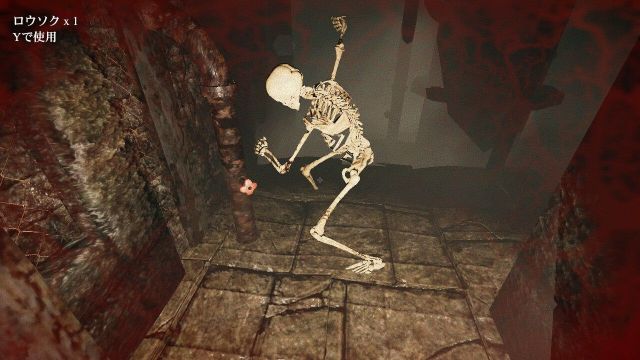The kind of experience that Dungeon Nightmares 1 & 2 champion is the kind of thing that goes down really well with YouTube and Twitch. Do a search for either title and you’ll see a wall of “OH! LOOK HOW SCARY IT IS!” and “SCARIEST GAME EVER!” descriptions, while the icons show people screaming in the terror that they’re apparently experiencing. It is, of course, funny to watch, and that is the appeal – we love YouTube horror bait because we love laughing at those silly little performative screams – but the sad reality is that neither Dungeon Nightmares, nor its sequel, are anything more than a giggle to play, either.
Jump scares are, of course, a critical part of the horror lexicon, and when they’re done well, jump scares are visceral and hugely entertaining. A good jump scare makes us leap out of our chair, and then laugh at the absurdity of being so drawn into the experience that, even though we know we’re playing something fabricated, we still have that instant, split-second flight response. In fairness to Dungeon Nightmares 1 & 2, the primary purpose for these games to exist is to provide players with jump scares, and they hit the brief so perfectly it’s hard to criticise them for it.
The jump scares in these games work for two significant reasons: firstly, the levels are procedural in design, which means that the game does sacrifice the ability to give players some intense, carefully crafted and interesting level design, but in exchange, it ensures that no matter how often you play, you will be constantly contending with the unknown. You’re never going to quite know when a monster’s going to find you, and those searches for keys and switches to escape the level will be that much more intense when you can’t memorise their locations. Procedural provides the perfect gameplay structure for jump scares, is the point here. The second reason Dungeon Nightmares works as a jump scare factory is that it is so, so dark. Even when you’ve got one of the scarce candles (which act as light sources), you can never quite pierce the darkness more than a hand or two in front of your face, which leaves you in a constant state of unease about what might be lurking a less-than-safe distance away from you.
These elements combine in such a way that when a monster does jump at you, with a far-too-loud growl or screech, you are primed to jump out of your skin. It’s an involuntary reaction, and it goes down a treat on YouTube, each and every time. A second later you’re having a giggle about it though, especially since, with Dungeon Nightmares, getting scared by any of it is a joke. The enemy monsters are so simultaneously generic and over the top that they’re about as meekly terrifying as a haunted house mannequin that has been removed from context (for example, placed outside the house in the sunlight). The environments that you explore are just corridors and rooms, and the randomisation means that the levels are generic building blocks and little else. When you play Dungeon Nightmares, you’re playing for those split seconds when a monster leaps out at you, you jump, try to escape, and then have a laugh at the end of it all, because the reality is that it’s just not scary outside of those fractions of a moment.
As effective as both Dungeon Nightmares 1 & 2 are at their one and only gimmick, they offer nothing more beyond that. The narrative is a very simple reflection on the impact of nightmares (and I guess the procedural generation goes to speak to the cluttered state of the conscious mind), but does so little with that theme it’s almost ridiculous that the developer includes (short) sections of the second game that are entirely built around storytelling. They just should not have bothered. Later stages of both games also start throwing gimmicks at the player that seem incredibly unfair, especially since they’re in combination with the monsters, and there are so few ways to overcome the challenges. If you’re going to have undefeatable stalker monsters, then fine, but give us a way to hide or temporarily incapacitate them.
But most critically of all – thematically Dungeon Nightmares is bad horror. Yes, it’s good at jump scares, but that is the most primitive and intellectually uninteresting kind of horror out there, and it’s so fleeting that if there isn’t context to it, it comes across as hollow and shallow. Yes, once an enemy spots you, the mad flight through labyrinthine corridors and tunnels, when it’s so dark you can’t see anything, is an instant kind of excitement. And, yes, it is wonderfully atmospheric when you’re creeping around and hear a door in the not nearly distant enough distance open and shut. Did the monster come, or go? Do I advance, stay put, or get the hell out of there? It builds the atmosphere nicely.
All of this matters because horror, when it’s not saying something, is really just atmosphere and theatrics. That’s not necessarily an inherent criticism; if you’ve ever been through one of the haunted houses that pop up in Japan every summer you’ll know how much fun they can be. But the question here is whether Dungeon Nightmares is really “scary,” and effective as horror, or a temporary distraction and a bit of fun.
It’s the latter. It’s not an expensive little collection, and in fairness with both lasting around 10 hours (depending on how frequently you die) there’s plenty of content to enjoy and/or create some hilarious YouTube videos with. But there’s nothing meaningful nor memorable about Dungeon Nightmares, and the Nintendo Switch is not poorly served for the horror genre. Alien: Isolation is an infinitely better stalker horror experience, Outlast and its sequel are there if you’re looking for degenerate thrills, and Lust for Darkness, Death Mark and Tokyo Dark occupy the more thinky end of the horror spectrum. And, of course, there are all the Resident Evil action games you could imagine. Hell, I’d recommend Five Nights at Freddy’s over this collection. The specific niche for Dungeon Nightmares starts and stops at people that want stupid jump scares and literally nothing else in their horror.
– Matt S.
Editor-in-Chief
Find me on Twitter: @mattsainsb










